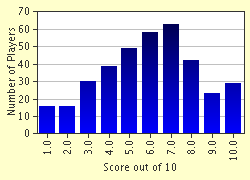Quiz Answer Key and Fun Facts
1. Perhaps the most popular Golem story concerns the creation of one of these creatures by the great author and spiritual leader Rabbi Judah Loew ben Bezalel (1525-1609) to protect his people from a pogrom (a campaign against the Jews). In 1996, a children's book by David Wisniewski centered around this story won a Caldecott medal. In what city is this story set?
2. In the most famous Golem tale, how does Rabbi Loew animate the Golem?
3. At first, all went well with Rabbi Loew's Golem. He served as a good protector of Prague's Jewish community, and the people were happy. After a while, however, he began to be a problem, though various versions of the story differ as to what that problem might be. Which of these is NOT commonly cited as a problem with the Golem?
4. There are various ways that the Golem is destroyed (or at least put to sleep) in different stories. Which of these is not one of them?
5. At the end of the story, the Golem has been rendered inert, and now, years later, no one knows how it may be reanimated. According to legend, where does the Golem's body now lie?
6. In addition to its role in folklore, the Golem has also been a question of Jewish theology. One classic question, for example, is whether a Golem can be counted when forming a minyan. What is a minyan?
7. To what Biblical figure is the Golem most often analogized?
8. According to one early Golem story, the prophet Jeremiah created a Golem through sacred inspiration and a thorough study of the Book of Creation over three years. This Golem rebuked Jeremiah, however, saying that in creating an artificial man Jeremiah had set himself up to be like G-d. How did Jeremiah undo his creation?
9. There is another story about a Golem created by Hebrew poet Rabbi Solomon ibn Gabriol (1021-1056). When Ibn Gabriol was denounced to authorities, he revealed the Golem to be less than human and restored his creation to inanimate pieces of wood. Aside from the use of wood instead of clay, how did this Golem differ from most of those in other stories?
10. The Golem legend has also figured as an influence in contemporary motion pictures. One of the first such specimens, the 1920 German silent film "Der Golem", is ranked today as a classic of German Expressionism. What later American movie masterpiece is usually cited by critics as being heavily influenced by "Der Golem"?
Source: Author
Stuthehistoryguy
This quiz was reviewed by FunTrivia editor
ArleneRimmer before going online.
Any errors found in FunTrivia content are routinely corrected through our feedback system.

